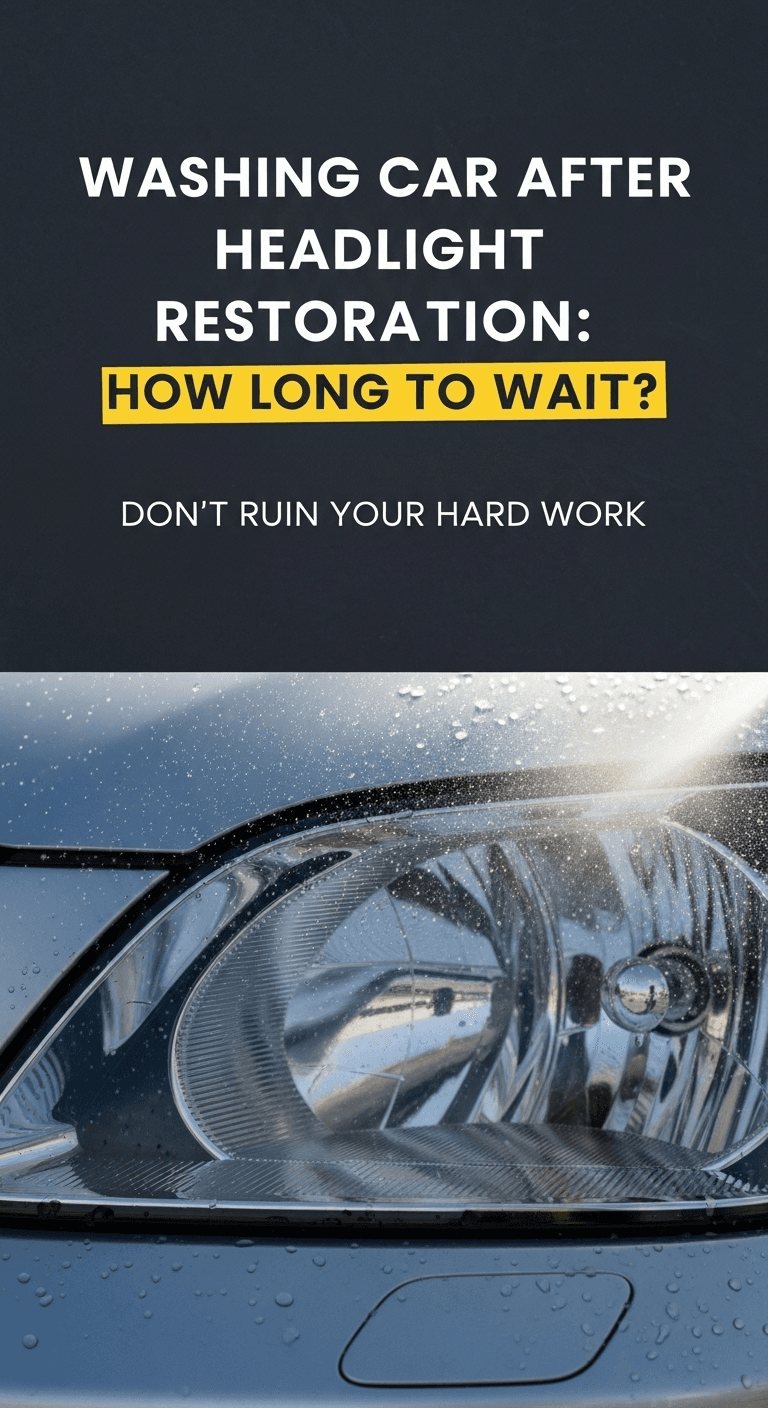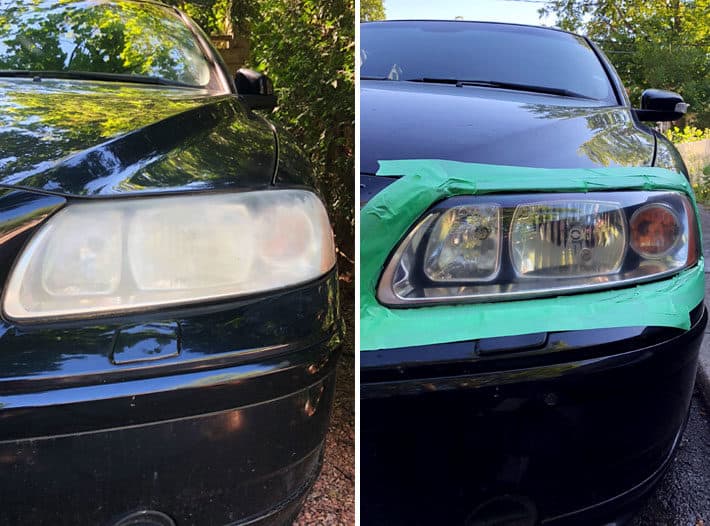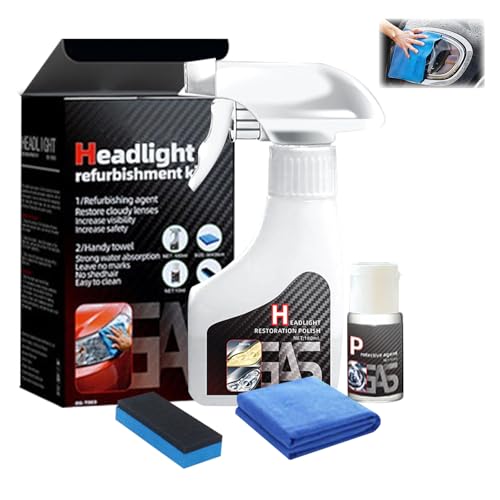You’ve just spent time and effort restoring your headlights to a crystal-clear shine, banishing that ugly, yellowed haze for good. But now a new question looms: how soon can you wash your car without ruining your hard work and undoing the entire process? The fear of damaging that fresh, protective coating is real, and the wrong move could send you right back to square one.
Yes, you can wash your car after headlight restoration, but you must wait at least 24 hours. For best results, especially with professional-grade coatings, waiting up to three days is recommended to allow the new protective coating to fully cure.
This guide cuts through the confusion, leveraging extensive analysis of manufacturer guidelines and auto detailing expert consensus. We will unpack the critical difference between “drying” and “curing,” detail the key factors that influence your wait time, and provide the exact steps for safe washing and long-term care. You’ll learn not just what to do, but why you’re doing it, ensuring your headlights stay pristine for years to come.
Key Facts
- The 24-Hour Rule is Standard: The general consensus among experts is to wait a minimum of 24 hours before any water or chemicals touch the restored headlight surface.
- Curing is a Chemical Process: A restored headlight may feel dry to the touch in an hour, but it requires a much longer period to “cure,” which is a chemical hardening process that ensures maximum durability.
- Professional Coats Need More Time: While most DIY kit sealants cure in 24 hours, professional-grade urethane-based clear coats can take up to three days to fully harden, as noted by product manufacturers.
- Temperature is a Major Factor: As highlighted by data from sources like Delta Kits, the ideal temperature range for proper curing is between 50°F and 100°F (10°C and 38°C). Colder weather can significantly extend the necessary waiting period.
- Hand Washing is Safest: After the curing period, a gentle hand wash is strongly recommended over automatic car washes or high-pressure sprayers, which can damage or even mar the new protective coating.
The Golden Rule: How Long to Wait Before Washing Your Car After Headlight Restoration
Yes, you can wash your car after headlight restoration, but you must wait at least 24 hours. For best results, especially with professional-grade coatings, waiting up to three days is recommended to allow the new protective coating to fully cure.

This isn’t just arbitrary advice; it’s the golden rule backed by expert consensus and product manufacturers. The protective UV coating applied at the end of the restoration process is the single most important element for longevity. It’s this clear layer that fights off the sun’s damaging rays and prevents the lens from oxidizing and turning yellow again. Giving it the uninterrupted time it needs to fully bond and harden is essential for getting the long-lasting results you expect.
The bottom line is that the coating must be allowed to fully cure. Introducing water and cleaning chemicals prematurely can weaken the bond, compromise the protective layer, and drastically shorten the life of your restoration.
But why is this waiting period so critical? It all comes down to the science of what’s happening on the surface of your headlight lens.
Understanding the “Why”: The Crucial Difference Between Drying and Curing
One of the biggest mistakes you can make is confusing “dry to the touch” with “fully cured.” While a freshly restored headlight might feel dry within an hour, the chemical process that gives the new coating its strength and resilience has only just begun.
Think of it like baking a cake. It might be cool to the touch on the outside (dry), but the inside still needs time to set completely (cure). Cutting into it too early results in a gooey mess. Similarly, washing your car too soon interferes with the coating’s internal chemistry.
Here’s the technical breakdown:
- Drying: This is a physical process. It’s the initial stage where the solvents in the coating simply evaporate into the air. The coating feels solid, but its molecular structure is not yet locked in. This happens relatively quickly, often within 4-6 hours.
- Curing: This is a chemical process. During curing, polymer chains within the coating cross-link with each other, forming a strong, durable, and resilient matrix. This is what gives the coating its hardness, chemical resistance, and ability to protect against UV damage. This process is much slower and requires at least 24 hours.
Washing a headlight that is only dry—but not cured—means you are exposing a vulnerable, still-reacting surface to water and detergents that can disrupt this vital chemical bonding process.
What Affects the Curing Time? Key Factors to Consider
The 24-hour rule is a great baseline, but the ideal curing time for your specific headlight restoration can be influenced by several environmental and product-related factors. Being aware of these variables allows you to make the most informed decision to protect your work. Always refer to the manufacturer’s instructions for the specific product used, as this is the ultimate source of truth.
| Factor | Ideal Condition | Impact on Curing |
|---|---|---|
| Temperature | 50°F – 100°F (10°C – 38°C) | Colder temps slow chemical reactions, extending cure time. Extreme heat can cause the coating to run. |
| Humidity | Low to Moderate | High humidity can trap moisture in the coating, slowing the evaporation of solvents and hindering the curing process. |
| Type of Coating | Per Manufacturer Specs | DIY kit sealants often cure faster than professional-grade 2K urethane clear coats, which need more time. |
| Airflow | Gentle, consistent airflow | A fan can help solvents flash off initially, but avoid direct, focused heat from a heat gun after the first 10 minutes. |
Pro Tip: Use a fan for constant airflow after the first 10 minutes to aid curing, rather than a focused heat gun which can cause issues like running or uneven drying.
The Type of Protective Coating Matters
Not all headlight restoration coatings are created equal, and the type used is the most significant variable affecting the wait time before you can wash your car after headlight restoration.
- Standard Kit Sealants: Most consumer-grade headlight restoration kits come with a wipe-on sealant or UV protectant. These are designed for user-friendliness and typically achieve a full, hard cure within 24 hours under ideal conditions.
- Professional Urethane Clear Coats: A more robust and long-lasting method involves spraying the headlight with a 2K (two-part) urethane-based clear coat. This is the same type of durable coating used on your car’s paint. According to automotive sources, this type of coating is far more durable but requires a much longer curing period, often up to three days, to achieve maximum hardness and chemical resistance.
Safe Washing Techniques After Your Headlights Have Cured
Once you’ve patiently waited for the coating to fully cure, you can wash your car with confidence. However, to preserve the finish for the long term, how you wash matters. Adopting these best practices from auto care experts will ensure your restored headlights stay brilliant.

- Wait for the Full Cure: First and foremost, do not wash the car until at least 24-72 hours have passed, depending on your coating type and the conditions.
- Opt for a gentle hand wash: For the first few washes, a hand wash is vastly superior to an automatic car wash. You have complete control over the pressure and materials used.
- Use non-abrasive cleaners: Stick to a quality, pH-neutral car shampoo. Avoid any harsh degreasers, all-purpose cleaners, or detergents containing abrasive materials directly on the lenses.
- Choose a soft microfiber wash mitt: A soft, clean microfiber mitt is the best tool for the job. It traps dirt away from the surface, minimizing the risk of causing micro-scratches on the new coating.
- Avoid high-pressure water: Do not use a pressure washer directly on the headlights. Even if the coating is cured, the intense force can potentially mar the surface or weaken the bond over time.
- Dry with a separate, clean microfiber towel: Use a dedicated, plush microfiber drying towel and gently pat the headlights dry. Avoid aggressive rubbing or using old, contaminated towels.
Quick Fact: Using a soft microfiber cloth isn’t just about preventing scratches; it ensures even pressure and a streak-free finish on the new coating.
Long-Term Care: Keeping Your Restored Headlights Crystal Clear
Your job isn’t done after the first wash. Headlight restoration is not a permanent fix, but with proper maintenance, you can dramatically extend its life and keep your headlights looking new. Think of headlight protectant like sunscreen for your car. A quick reapplication every few months can prevent years of damage.
According to data from restoration specialists, a quality headlight restoration can be expected to last anywhere from one to three years, depending heavily on maintenance, environmental factors, and the quality of the UV coating used.
Here are the key strategies to maximize the lifespan of your restoration:
- Regular, Gentle Cleaning: Wash your headlights regularly using the safe, non-abrasive methods described above. This prevents the buildup of grime and contaminants that can degrade the protective coating.
- Periodic Reapplication of UV Protectant: This is the most effective step. Every 3-6 months, apply a dedicated UV-resistant sealant or ceramic coating designed for headlights. This replenishes the protective layer that wears down over time.
- Park Smart: The sun’s UV radiation is the primary enemy. Whenever possible, park your car in a garage or in a shaded area. If you must park in the sun for extended periods, a car cover can provide excellent protection.

By following these simple long-term care steps, you protect the investment you made in restoring your headlights, ensuring maximum visibility and a sharp appearance for your vehicle.
To keep your headlights protected for the long haul, investing in a quality sealant is a brilliant move. A good headlight sealant and protectant kit makes periodic reapplication simple and effective, extending the life of your restoration.
FAQs About Washing Your Car After Headlight Restoration
What happens if I wash my car too soon after headlight restoration?
Washing your car too soon is the fastest way to ruin your restoration. Water and chemicals can interfere with the chemical curing process. This can lead to a variety of problems, including:
* Weakening the bond between the coating and the lens.
* Creating streaks or a hazy finish.
* Reducing the coating’s effectiveness against UV rays.
* Causing the coating to peel or flake off prematurely, leading to rapid re-yellowing.
Can I take my car through an automatic car wash after headlight restoration?
It is highly recommended to wait much longer than the minimum 24-72 hours before using any automatic car wash. Brushed washes are a high risk because the aggressive, often dirty brushes can easily scratch and mar a new coating. Touchless washes are safer but still use harsh, high-pressure chemicals that could potentially harm a coating that hasn’t achieved maximum hardness. A gentle hand wash is always the safest option.
How long does headlight sealer take to dry versus a 2K clear coat?
There’s a significant difference. Most DIY kit sealants are formulated to cure relatively quickly, typically needing about 24 hours to fully harden. A professional urethane-based 2K clear coat is a much more robust and durable solution but requires a longer curing period. For these professional-grade coatings, you should wait up to three days for them to achieve maximum hardness and longevity before washing.
What if it rains after I restore my headlights?
Rain is an understandable concern. It’s best to avoid all water exposure, including rain and even heavy morning dew or condensation, for at least the first 4-6 hours and ideally for the full 24-hour curing period. If possible, perform the restoration in a garage or carport. Check the weather forecast beforehand and try to schedule the job when you have a clear 24-48 hour window. If unexpected rain occurs, gently blot the headlights dry with a clean microfiber towel as soon as it is safe to do so.
Final Summary: Protecting Your Investment in Clear Headlights
Patience is the key to success when you can i wash my car after headlight restoration. While it’s tempting to clean your car immediately to admire your gleaming, like-new headlights, respecting the curing process is the most critical step. By understanding the difference between drying and curing and waiting the appropriate amount of time, you ensure the protective UV coating forms the hard, durable shield necessary to fight off discoloration for years.
- Wait to Wash: The absolute minimum waiting period is 24 hours. For professional-grade clear coats, extend this to 3 days for the best results.
- Curing is Chemical: Remember that the coating needs time to chemically harden and bond, a process that takes much longer than simply feeling dry to the touch.
- Wash Gently: Once cured, always opt for a gentle hand wash with a microfiber mitt and pH-neutral car soap. Avoid automatic car washes and high-pressure sprayers.
- Maintain for Longevity: Protect your work by periodically reapplying a UV sealant every few months and parking in the shade whenever possible.
Now that you have the expert-backed guidelines, you can confidently care for your newly restored headlights and keep them shining bright for years to come
Last update on 2025-12-02 / Affiliate links / Images from Amazon Product Advertising API













